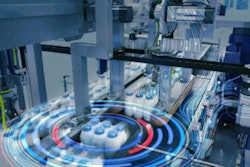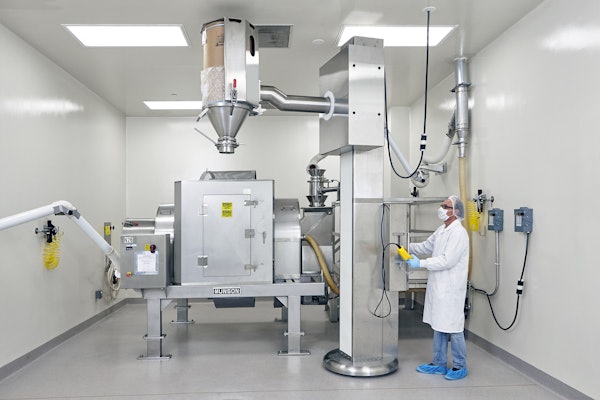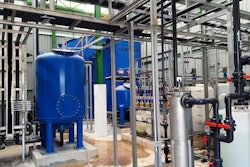Some of the biggest challenges facing CPGs today include labor shortages, supply chain issues, and the need for increased automation. Recognizing this, PMMI Business Intelligence commissioned a report on Warehousing Automation to offer potential solutions to these growing challenges. unPACKed sits down with Jonathan Pipe Senior Consulting Analyst for Interact analysis who researched the report and discussed how the growth of e-commerce and direct-to-consumer shipping is also driving the need for warehouse automation. Pipe explains how warehousing automation aids worker issues, and the direct impact CPG companies who are investing in automation are finding when it comes to handling the increased complexity of e-commerce fulfillment.
Download 2023 Packaging and Automation in the Warehouses of the Future
To subscribe, rate, review, and find more unPACKed podcast episodes, visit pmmi.org/podcast or find us on Apple Podcasts, Spotify, iHeart Radio, or wherever you listen to your podcasts.
Sean Riley:
So with all the fancy introductions out of the way, welcome to the podcast, Jonathan.
Jonathan Pipe:
Hi Sean. Thank you for having me.
Sean Riley:
Oh, the pleasure is all ours. From the top, the first thing we should really clear up for everybody listening in, why have we conducted this study specifically focusing on warehouse automation? It's pretty targeted, so what were sort of the reasoning behind putting this study together?
Jonathan Pipe:
I think the main reasons for the PMMI looking to do this study comes from the research we did with them last year where we were looking broadly at the future of automation across the entire production line. And we saw last year that CPG companies are facing a lot of challenges. You have supply chain issues, things like availability of parts and costs going up, cost of new machinery, cost of raw materials. But the big issue that was having the biggest impact and was seen to be the long-term issue was labor shortages, which is impacting everyone, but especially impacting manufacturing CPG companies. And for some of the companies, it was really a case of they had to automate their production lines or stop production and the most manual areas of their production lines, they had the most completely manual processes or a lot of semi-automatic processes that still require some manual input, were within the warehouse and at the end of the line.
So warehouses were really ripe for automation. It seems like a huge opportunity. With a lot of the CPG companies that I interviewed and my colleague spoke to, say that they were really focusing on the warehouse because in some cases, I think it was around half of the CPGs we surveyed, said that the warehouse was becoming a bit of a bottleneck where they were actually having to slow production down in some cases in order to accommodate the really manual warehouse. So it was a real focus of that study in 2022. And so the PMMI decided to commission this study looking specifically at the warehouse and packaging machinery within that and how automating the warehouse is going to have an impact on investment in packaging machines by CPGs.
Sean Riley:
That's very interesting because that's another a topic that we touch on a lot is the labor shortage, particularly how it's impacting manufacturing. So I guess beyond the labor shortage and the issues that that has on warehousing, are there other driving factors behind the growth in warehouse automation?
Jonathan Pipe:
Definitely. I mean, we've seen warehouse automation sector has grown dramatically. So I think our interaction analysis have done some research, and our report on warehouse automation shows that warehouse automation sector in the US specifically has doubled from 2018 to now, and then it's going to continue to grow until 2027 and beyond and probably double again by 2027. And there's two driving factors as you say, labor shortages are one and then the other big thing that I'm sure everyone is aware of is direct to consumer shipping and e-commerce. So more and more shopping is being done online and even now it's still growing. We're doing more and more shopping online, we're buying more things and things are being shipped directly to us much more often. So we've seen quite a growth in that. And in our research, that's something that came out quite strong. So in 2023 of the CPGs we surveyed, around 15% of their business is shipped directly to consumers, but that's actually going to increase to over 20% by 2026. So that's a 25% increase, which is huge. That's millions and millions of dollars of revenue.
And that's being driven by a couple of things. I mean, we've seen quite a few large CPG brands opening e-commerce platforms, the likes of Pepsi, they opened a couple of websites, I think one was snacks.com during the pandemic where they ship directly to consumers and they're not the only ones. There's lots of large brands doing that. So that growth in the amount of business going direct to consumers is definitely going to come from those larger CPG companies who see this as a real opportunity and that's really going to drive automation.
Sean Riley:
Okay. So kind of expanding on that e-commerce a little bit, how is that directly impacting warehouse automation strategies? What are they doing to attack that e-commerce so that it isn't a bottleneck?
Jonathan Pipe:
Yeah, absolutely. Well, with more e-commerce, you're going to see reduced pack sizes that increases the complexity of the operation throughout the whole line, but especially at the end of the line. So we're going to see more automation there to deal with that increased complexity. In our survey, it was around 48%, so they're investing in automated machinery and 43% of CPG said they're invested in packaging machines directly because of an increase in direct consumer fulfillment. So it's having this direct impact on investment in the machines. They're moving away from manual processing and they're moving away from full pallets as well. Not completely, full pallets account for the majority packages coming out at the end of the lines, and they'll continue to do so. But our survey has shown that use of mixed pallets is definitely going to increase, and that's something that we discussed with a lot of CPG companies and they were saying that they're going to start to use more mixed pallets.
They might not move all the way to just shipping each directly and individual items, but they're definitely going to see an increase in use of mixed pallets, which again increases the complexity and increases that need for automation. And it does have a direct impact as well. So within our research, we actually asked how much money CPG companies had spent on packaging machines last year, and those companies that do more than 20% of their business direct to consumers spend about 20% more on packaging machines. So if you are shipping items directly to consumers, you need it to take that packaging in-house and fulfill that yourself. So that's something that we're seeing is that's really driving investment in the machines.
Sean Riley:
Wow. Yeah, that's a lot of money that you're talking about being spent there. So I guess with all this talk of automation and warehouse automation, I guess could you kind of paint a picture of what the next few years are going to look like for CPG automation strategies?
Jonathan Pipe:
Yeah, definitely. I mean, there was a few things that came out. We spent a lot of time talking to experts at CPG companies and one thing that was talked about a lot was mobile robots. And in our survey of CPG companies, 25% of our respondents said that their company plan to invest in mobile robots. Now, whether they actually do end up doing so will be interesting, but that's a huge number that are interested in doing that and are sort of starting to plan for investing in mobile robots. And we know that mobile robots are very expensive, so it's likely to be the largest CPGs that are going to be able to invest in mobile robots, but those seem to be the technology that is most exciting for CPGs and has the most potential.
What was really interesting was that although quite a lot of CPGs are saying that they plan to invest in mobile robots, it was only around 10% so that they thought mobile robots had a lot of cost saving potential. So there's a bit of a gap there, and that implies that the investments that they're making, and especially in mobile robots are being done out of necessity, not necessarily out of cost saving or return on investment. It's just being driven purely by these labor shortages. They don't have the people anymore to do the work, so they're having to buy this technology. They're not really focusing on the cost and the return on investment at all. It's more, "I need this to fulfill the function that I'm doing."
Another thing that came out that was really important is, because CPGs are really dealing with a lot of labor shortages at the minute, worker comfort is becoming increasingly important. So we're seeing that machines are having to be more ergonomically tested, they're having to be more comfortable. A good example of this was forklifts, which obviously, quite different to some of the other machines used, but if you're working in a warehouse and you're in a forklift that is uncomfortable, not easy to use, versus the warehouse next door who've got air conditioning forklifts, they've got USB ports, they've got places to put your drink, the comfier seats, you've got more leg room, it's just more appealing to work in that environment.
So worker comfort is now more important for retention of staff, but also appealing to new employees. And that's not just in forklifts, that's across all machinery types. And ultimately the most comfy place to work is in an office or at home. So we're starting to see more interest in remote services, remote monitoring, remote operation of some of these machines than we have before.
Sean Riley:
So from thinking about all this while I'm sitting here thinking of this warehouse automation strategies and warehouse automation in general, I guess I'm trying to think, what are the plans for third party logistics companies when it comes to automation? How are they going to handle this?
Jonathan Pipe:
Yes, definitely. I mean, 3PLs are really quite important. So I mentioned earlier about if you have more than 20% of your business going direct to consumers, you spend more on packaging machines. But what we're seeing is that if you have less than 20% of your business going direct to consumers, you actually are more reliant on a third party logistics provider to fulfill that for you. So there's this divide here where you've got some CPG companies taking it in-house and some CPG companies relying on a 3PL to do this for them, which is really interesting. And it meant that when we were doing our research, we realized we had to sort of pivot and look at 3PLs strategy because they're really important to how CPGs are thinking about fulfilling direct to consumers. And historically, 3PLs have been quite manual and they haven't invested much in warehouse automation.
That's primarily because they need flexibility. So they need to be able to change skews package sizes, completely change how they're processing items quite quickly because they're working with multiple partners, they've got different items coming through. But we're starting to see this change. We're seeing some larger 3PLs now starting to invest in more mobile automation solutions because 3PLs are so reliant on manual labor, they're much more susceptible to the labor shortages that we're seeing. So they're becoming more reliant on temporary workers. And once the company's reliant on temporary workers, it's hard for them to invest in automation technologies because of the risk of disruption.
So really for 3PLs, the investment in automation technology is focused on new facilities rather than developing their existing centers that it's anywhere that's a new sortation center, a new fulfillment center, that's where they're looking to automate. And those 3PL companies that are able to invest more in automation tend to have one large partner where they can control skews package sizes better. And the technology they're interested in is very similar to CPGs. Again, the buzzword was mobile robots.
But what's enabling 3PLs to be interested in buying these robots is robots as a service. That's really important to them. They don't want to have the upfront cost of buying a mobile robot or a machine. They're just looking for that as a service model that's really enabled them to start to automate. And the future of 3PL strategies, a really interesting area. We had some discussions in depth with experts and leaders at some 3PL companies in the US and they're all talking about starting to specialize. So we're starting to see more 3PL companies just focus on distribution and transport or some focus on tertiary packaging, some focusing on secondary packaging. And what that means is that you're starting to see more segmentation, which will increase the complexity for CPG companies who are using 3PLs in the future. So we might start to see even more CPG companies take this direct to consumer shipping in-house rather than relying on a partner.
Sean Riley:
Interesting. Now, there has to be, since we're not talking across the board with this automation, we're talking percentages and they're high percentages. But I guess what are some of the factors that are holding back investment from other companies or other people that might be interested in employing this or deploying this automation?
Jonathan Pipe:
Yeah, it's an interesting area. I mean, you would expect it would be cost and return on investment, but it's not actually. And from our survey, it was the fact that the warehouses that these people are working in and a lot CPGs are using are old. They've got poor layouts, they've got a difficult layout. I mean, some of the CPGs are operating out of warehouses that are even up to 100 years old and they've got limited space or they've got narrow corridors or floors that aren't level. They're over multiple floors. So it just doesn't lend itself well to automation. And that was the biggest factor that was preventing CPGs from automating their warehouses, which seems like an impasse, something that OEMs are going to struggle to get past. But the CPGs I talked to, I sort of said, how can OEMs help and how can they get to a solution that allows you to automate?
And they were saying that actually if you sit down with an expert who really understands their technology and what their technology can achieve, along with someone who understands CPGs limitations, what they're trying to fulfill, how their operation works and what the issues are, there is usually a way of getting automation to work in those facilities. And it could be quite complicated, but actually having those two people communicating and collaborating together usually comes to a solution. So it just shows how important partnerships are going to be going forward to really work out how can we get automation to work in this difficult space.
A couple of other things that were important as well going forward. A lot of the CPGs were saying that they need flexibility and simplicity from the machines going forward. So those are the two most important things that they're looking for. They need to be able to change output from production lines quickly. That's important for CPGs and 3PLs, but they don't want to invest in an automation machine. That means that they can't do that, so they don't want to lose that ability to be agile. So OEMs sort of need to think about that when they're thinking about their machines, but also they want the next generation of machines to be easy to operate and maintain because of the labor shortages we've got. There's less and less skills in the workforce. So having simple machines that are easy to use, but they can be flexible as well, that's really the key for CPGs going forward.
Sean Riley:
That's awesome. And this was an awesome summary of what I anticipate to be a really impressive report. So I guess, to kind of put a button and wrap this up for everybody, how can people find out more about this research? Where can they find the report and potentially take part in future studies?
Jonathan Pipe:
So this report will be available on the PMMI's website before the end of September. It'll be promoted to members, so you should be able to find it. There's also going to be a webinar taking place, discussing some of the results and some of the things that I've spoken about here. So look out for that. I think that's in early October. The previous year's study is already on the PMMI website, and that has a lot of information that leads into this nicely. So it's worth going and downloading that report and having a look at that as well.
And on the back of this study, we've seen how impactful labor shortages have been, and the PMMI are really interested in how remote service and monitoring can play a role in helping CPG companies cope with those labor shortages. So we're undertaking a study right now looking at that market, the potential of it, potential limitations. So if anyone has insight and wants to be involved in that, please feel free to reach out to the PMMI business intelligence team or to meet directly, and we'd love to spend 10, 15 minutes talking to someone at CPG company or an OEM who has insight in that area.
Sean Riley:
Perfect. I love that. Well, I can't thank you enough for coming on here, Jonathan, and giving us a synopsis of what I anticipate to be a really, really cool report. So yeah, again, thank you for coming, taking time out of your day to come on here on this podcast with us.
Jonathan Pipe:
Yes, thank you very much for having me.



















